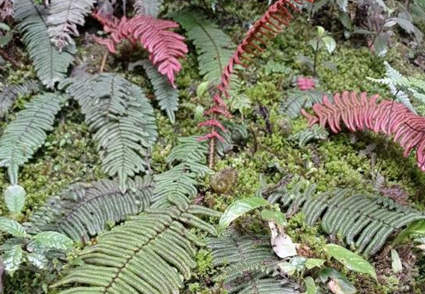Abstract
Parablechnum prostratum, a new species with dimorphic leaves from southern Colombia, is described and illustrated. The new species is characterized by featuring prostrate sterile leaves, a unique character within the genus. Morphological similarities and resemblances to other species of Parablechnum are discussed.
References
Brownsey, P.J. & Perrie, L.R. (2021) Blechnaceae In: Breitwieser, I. (Ed.) Flora of New Zealand: ferns and lycophytes, Fascicle 29. Manaaki Whenua Press, Lincoln, pp. 1–91.
Dittrich, V.A.O., Smith, A.R. & Gasper, A.L. (2017) Parablechnum roraimense and P. paucipinna spp. nov. (Blechnaceae: Polypodiopsida), lectotypification of P. stuebelii, and citation corrections in the family. Phytotaxa 292: 65–73. https://doi.org/10.11646/phytotaxa.292.1.6
Gasper, A.L., Dittrich, V.A.O. & Salino, A. (2016) A classification for Blechnaceae (Polypodiales: Polypodiopsida): New genera, resurrected names, and combinations. Phytotaxa 275: 191–227. https://doi.org/10.11646/phytotaxa.275.3.1
Gasper, A.L., Almeida, T.E., Dittrich, V.A.O., Smith, A.R. & Salino, A. (2017) Molecular phylogeny of the fern family Blechnaceae (Polypodiales) with a revised genus level treatment. Cladistics 33 (4): 429–446. https://doi.org/10.1111/cla.12173
ITHAKA. (2000–2023) Global Plants. JStore. Available from: https://plants.jstor.org/ (accessed: March 2023).
Lellinger, D.B. (2002) A modern multilingual glossary for taxonomic pteridology. Vol. 3. American Fern Society, Washington, 263 pp. https://doi.org/10.5962/bhl.title.124209
Molino, S. Gabriel y Galán, J.M., Sessa, E. & Wasowicz, P. (2019) A multi-character analysis of Struthiopteris leads to the rescue of Spicantopsis (Blechnaceae, Polypodiopsida). Taxon 68: 185–198. https://doi.org/10.1002/tax.12036
Molino, S. (2022) Sinopsis global y aproximación a la filogenia molecular del género Parablechnum C.Presl (Blechnaceae, Polypodiopsida). Ph.D. Thesis, Universidad Complutense de Madrid. Madrid. 445 pp. [https://eprints.ucm.es/id/eprint/75407/1/T43509.pdf]
Moran, R. (1995) Five new species and two new combinations of ferns (Polypodiopsida) from Ecuador. Nordic Journal of Botany. 15: 49–58. https://doi.org/10.1111/j.1756-1051.1995.tb00120.x
Murillo-P., M., Murillo-A., J. & León-P., A. (2016) Pteridofitos (helechos y afines). In: Bernal, R., Gradstein, S.R. & Celis, M. (eds.) Catálogo de plantas y líquenes de Colombia. Instituto de Ciencias Naturales, Universidad Nacional de Colombia, Bogotá. pp. 446–578.
Presl, C. (1851) Epimeliae Botanicae. Amadei Haase, Prague, 264 pp.
Rojas, A. (2006) Two New Species of Blechnum (Blechnaceae) from the Neotropics. Brittonia 58: 388–394. https://doi.org/10.1663/0007-196X(2006)58[388:TNSOBB]2.0.CO;2
Rolleri, C. & Prada, C. (2006) Revisión de los grupos de especies del género Blechnum (Blechnaceae-Pteridophyta): El grupo B. penna-marina. Acta Botanica Malacitanica 31: 7–50. https://doi.org/10.24310/abm.v31i31.7119
Rolleri, C., Prada, C., Passarelli, L. & Gabriel y Galán, J.M. (2012) Revisión de dos especies de Blechnum de las regiones montañosas tropicales e intertropicales de Centroamérica y Sudamérica. Actes du Colloque Les Fougères d’Alsace, d’Europe et du Monde 1: 149–161.
Rodríguez, W. (2011) Pteridofitas. In: Idárraga, A., Ortiz, R. del C., Callejas, R. & Merello, M. (eds.) Flora de Antioquia: catálogo de las plantas vasculares. vol. II. Listado de las plantas vasculares del departamento de Antioquia. Programa Expedición Antioquia-2103. Series Biodiversidad y Recursos Naturales. Bogotá: Universidad de Antioquia, Missouri Botanical Garden & Oficina de planeación departamental de la gobernación de Antioquia. pp. 134–204.
Smith, A.R. & Kessler, M. (2018) Prodromus of a fern flora for Bolivia. XXXIII. Blechnaceae. Phytotaxa 334: 99–117. https://doi.org/10.11646/phytotaxa.334.2.1
Smith, A., Pryer, K., Schuettpelz, E., Korall, P., Schneider, H. & Wolf, P. (2006) A classification for extant ferns. Taxon 55: 705–731. https://doi.org/10.2307/25065646
Thiers, B. (2023 [continuously updated]) Index Herbariorum. New York Botanical Garden, New York, U.S.A. Available from: http://sweetgum.nybg.org/science/ih/ (accessed: March 2023).


